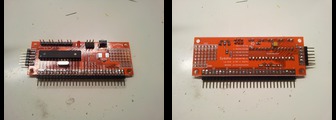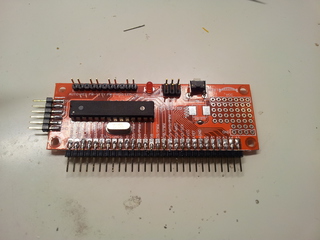This is the Syduino - my take on a breadboard friendly barebones Arduino clone. It was the last PCB I designed while we were still living in Sydney, so the name seemed apt. It was manufactured on 0.8mm FR4 material as part of a larger board hosting multiple designs. By using thinner PCB material it was possible to score the board with a knife and snap it, separating the Syduino from the other designs.
The design is an amalgamation of many designs I’ve seen and I can’t claim the originality of any of its features. Nevertheless here are some of its features and some thoughts about things considered during the design phase:
- The design tries to be usable as both an Arduino clone and as a generic AVR breakout board.
- The Arduino pinout is silkscreened on top and a table of AVR pin functions is provided on the underside for quick reference.
- All pins are broken out to a single-in-line header for inserting into a breadboard. Because the Syduino stands vertically it takes up very little space on the breadboard.
- The Arduino programming connections are on the left-side and mate nicely with a Sparkfun FTDI Basic Breakout board. When used as a generic AVR board, this connector can be used as a serial connection.
- The Arduino’s default auto-reset functionality can be enabled/disabled using a jumper (AUTO-RES).
- Power can be sourced from USB (via the FTDI breakout board), from the AVR programmer, or from an external source. This is configured using jumpers (PW-VTTY, PW-PROG).
- There is a LED to indicate the board is receiving power and this can be disabled by removing a jumper (LED-EN) in order to make accurate current measurements (say, for testing AVR sleep modes).
- The reset button is a side-mounted type so it is easily accessible when the Syduino is plugged into a breadboard
- A 6-pin AVR ISP programming header is provided for generic breakout board use or to program the Arduino bootloader. Unlike some of my earlier designs there is sufficient space around the header to accommodate the IDC cconnector and pin 1 is clearly marked!
- There is provision for an inductor to filter the AVCC line as recommended in the AVR datasheet. This can be bypassed for applications not using the ADC (IND_BYP).
- A small prototyping area is available for interfacing a sensor, RTC, or other simple device.
- There are mounting holes so the finished project can be mounted in a box.
A quick test confirmed that burning the boatloader works via the ISP header and uploading a sketch works over the serial connection.


